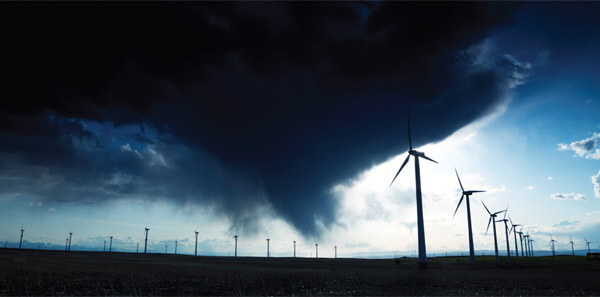How bad science stifles rational debate about wind power
Andrea McDowellWebsite

Stormy weather: pro-wind campaigns suffer from a lack of good, freely available data.
Wind energy ought to be a shoo-in. Yes, the infrastructure costs a lot of money but the fuel is free and plentiful, turbines produce no emissions, and no mountaintops need to be removed. And unlike nuclear power, no long-term radioactive waste needs to be stored for millennia. Yet, bizarrely, small groups of committed neighbourhood activists continue to band together to save the environment from wind energy.
It’s perplexing, and for those involved in climate change activism, inordinately frustrating to see people who could be allies persistently turn themselves into enemies. I’d love to point my finger at some fossil-fuel funded meanie trying to kill public support for wind, but the picture is far more complex.
A small, cherry-picked, and often factually incorrect collection of data without context circulates on websites and in reports. Since most people have neither the time nor the technical education to tease out the realities from the misinformation, confusion over the health, economic, environmental and climate-related impacts of wind energy reigns just when we need clean energy sources most.
But shouldn’t it be obvious when people are using bad science? To someone without a technical background, no. The thicket of information available online both pro and con is bewildering and vast, a tangle of contradictory claims without end.
As Farhad Manjoo wrote in his 2008 book True Enough: Learning to Live in a Post-Fact Society, the inherent biases of human reasoning in an era of infinite information causes precisely this situation: instead of determining truth through examining methodology, testability, reproducibility, and peer review, the average person decides to trust the conclusions of whichever speaker appears to have the most impressive or trustworthy credentials.
“Calculating the Real Cost of Industrial Wind Power,” is a 2007 report by retired phytotherapist Keith Stelling that is routinely used to bolster anti-wind arguments. The claims he advances—that wind energy slaughters bats and birds, depresses property values, produces infrasound damaging to human health and destabilizes the grid while increasing carbon dioxide emissions—rest almost solely on the names of his sources. These include Audubon Society, American Bird Conservancy (both of whom support wind energy, contrary to his report), Renewable Energy Foundation and the National Research Council. Thanks to their borrowed credibility, Stelling’s report has played a role in municipal wind-energy moratoriums from Bruce County, Ontario to Austin, Texas.
But are his sources credible? For instance, despite their name, the Renewable Energy Foundation (REF) is not on record as having supported a single renewable energy project, instead devoting their time and resources to discounting wind energy and mobilizing opposition. REF’s website contains only information about the downsides of wind energy, and until recently their mission statement included the necessity of “maintaining a non-confrontational relationship with fossil fuels.” Yet a single report by David White (former sales executive for Exxon and Esso Coal) for the REF is quoted in nine out of 27 pages in Stelling’s report.
A National Academy of Sciences report on wind energy is quoted in Stelling’s paper as having concluded that wind energy can “only” meet part of future American energy demand and is thus useless to combat climate change. The quote actually originated from a press release on the report by the Industrial Wind Action Group.
IWAG, for short, is a group “formed to counteract the misleading information promulgated by the wind energy industry and various environmental groups.” Their website contains mostly sympathetic newspaper stories and entirely lacks peer-reviewed or scientific research. When the American and Canadian Wind Energy Associations published last year a scientific review of the health impacts of wind turbine noise on human health, for example, IWAG ignored it. But when, earlier this year, the Society for Wind Vigilance (a small anti-wind advocacy group) published a rebuttal [PDF] including complaints about being labelled “detractors” and an insistence that a proper study should include non-peer-reviewed research, IWAG included it in their research database.
The statistics, claims and sources used by Stelling and the IWAG are widely recycled by anti-wind groups to further their cause. One often-repeated factoid states that “international property consultant Savills” claims that wind farms reduce farmhouse property values by 30 percent. Tracking the quote to its source reveals it originated in a single letter from a single real estate agent in Britain to one of his clients. In one of the greater ironies of the wind energy debate, Savills promotes wind energy and has a sideline of planning and conducting environmental assessments of wind projects. Anti-wind information is widely available for free online and relatively simplistic, while the science debunking these claims is complex and often hidden behind an academic journal’s pay-walls. Scientists need to be paid for their work, and academic journals need to earn money to function and publish—but this makes it very difficult to promote good information.
What is the solution? Barring destroying the internet, returning to a less-knowledgeable time and restructuring the education system by next Wednesday, who knows? Manjoo’s thesis suggests that trust is the crux of the issue. No doubt, local anti-wind organizers distrust consultants and experts perceived to be on the proponent’s side via the proponent’s payroll. This is because proponents are required to pay for the assessment of their projects.
A third party is needed: a group that stands to benefit in no way from the construction of any particular wind project yet that can access, translate and communicate scientific and academic findings to multiple audiences. It would put the NIMBYs and the YIMBYs on equal footing, allowing the benefits or drawbacks of a given wind development to be debated sensibly. As the climate change clock ticks down we need community organizers to mobilize as effectively for wind power as others mobilize against it.